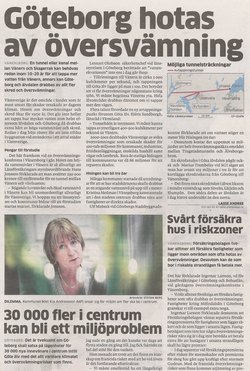 Throughout the Nordic region, after more than a decade of working with mitigation (or, the reduction of the causes) of climate change, it is becoming more common to hear calls for adaptation to the effects of climate change. Achieving such a shift in political focus is itself noteworthy, and has not come easily, but implementing the resultant policy decisions in terms of concrete response measures remains a challenge. Big questions emerge, and one of the biggest of them all is: Who pays? More specifically: Who pays for the research needed to assess the risks? Who pays for the changes in infrastructure that are required as a result of such analyses? Who pays for the damage where preventative measures prove to be inadequate?
Throughout the Nordic region, after more than a decade of working with mitigation (or, the reduction of the causes) of climate change, it is becoming more common to hear calls for adaptation to the effects of climate change. Achieving such a shift in political focus is itself noteworthy, and has not come easily, but implementing the resultant policy decisions in terms of concrete response measures remains a challenge. Big questions emerge, and one of the biggest of them all is: Who pays? More specifically: Who pays for the research needed to assess the risks? Who pays for the changes in infrastructure that are required as a result of such analyses? Who pays for the damage where preventative measures prove to be inadequate?
Intrinsic to the question of who pays for adaptation to climate change is the question: Who has the responsibility? Taking responsibility usually means, in political terms, paying the bill. Conversely, those who pay usually bear the responsibility for the adequacy and outcomes of whatever actions are taken. The issue with regard to climate change is that it has created a vast and empty political space, where neither the economics nor the questions of responsibility have been resolved to any satisfaction, let alone operational clarity. If you are, for example, a municipal housing director, a planner, or a regional emergency response coordinator, there are many aspects of such a situation that are challenging, even frustrating. At the same time as the assessments of vulnerability are gradually becoming more detailed, with the need for appropriate response ever more apparent, it is also becoming increasingly clear that society has a long way to go in resolving these issues. The vacuum of experience and initiative in reaching closure generates increased uncertainty, which itself in turn becomes a problem. An uncertain state of affairs is not a positive input to ambitions in the area of regional development.
Now, to return to the Vänersborg seminar, which represented a promising initiative in these matters. Organised through a collaboration between the Center for Climate and Safety, Karlstad University; Länsförsäkringar, an insurance company; Länsstyrelsen Värmland, and Länsstyrelsen Västra Götaland, the seminar's main question was, "What measures are needed and who has the responsibility?" Approximately 150 participants from a broad spectrum of actors (including Nordregio), deliberated this question throughout the one-day event, held on 20 January, 2010.
What united this diverse meeting of representatives of national agencies, county boards, companies, politicians, municipal planners, scientists, civil preparedness experts and media was a common concern with the geographic feature most likely to require adaptation as climate change proceeds, the entire water system incor-porating Lake Vänern, its tributaries and drainages. As Sweden's largest, and Europe's third largest, lake, it has an obvious re-presentative value. Many of the muni-cipalities around its shores have to con-tend with rising lake levels and subsequent flood-ing, often at great cost to society. The anti-cipation of in-creased precipi-tation dominates its most clearly defined climate change scenarios, and provides a common reference point for the inhabitants of the area. Building a drainage tunnel, or perhaps a canal, to the sea has long been proposed as a possible alternative, among others. Deciding and financing these ideas are, however, far from straightforward.
Who has the responsibility and who pays for adaptation to those scenarios and their eventual playing out? Or should it be stated the other way around: Who pays and who has the responsibility? The very fact that such a broadly representative stakeholder group gathered to share information, the latest scientific results, political intelligence and wise counsel is already progressive, but, as the consensus showed, mere talk is not, and will not, be enough, if even the mildest climate change scenarios for the region are realised. So, to bring the 250 000 SEK mentioned at the beginning back into the picture, the insurance company, Länsförsäkringar, pledged that amount at the seminar, to be used towards the funding of a feasibility study of how best to relieve the drainage pressure from Lake Vänern. The challenge to the other main actors present was clear: let's share in the costs and the responsibility. At the time of writing, Länsstyrelsen Värmland has matched the sum. It is perhaps not too much to predict that the communities around Vänern are becoming a showcase of how to initiate climate change adaptation.
(With thanks to Emilie Hindersson, Coordinator, Center for Climate and Safety, Karlstad University, for additional background information for this article.)
By Richard Langlais, former Senior Research Fellow, Nordregio